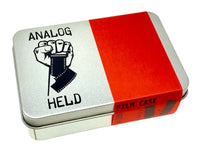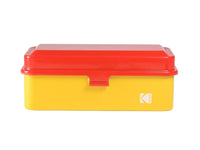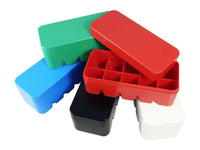Black Friday 2025 has landed at Analogue Wonderland, bringing some of our biggest film photography deals of the year - from discounted film and cameras to money-saving WonderLab processing offers, exclusive bundles, and festive specials available for a limited time only. Grab a great deal while stocks last!
Recent posts
Shop the article

How to Travel with Photographic Film
By Emma Lloyd
How to travel with film, another seemingly tricky question within the long list of analogue photography myths and fairy tales. But do not fear!
😊 This article aims to answer all your film photography travel questions, so by the time holidays are back on the cards you will be ready and raring to go. With your analogue gear safely in hand - regardless of whether you're going to North Wales or North Korea!
What's the problem with travelling and film photography?
To add to the wonderful year that was 2020, some of the major film brands such as Kodak, Fuji Film and Ilford issued warnings about new and enhanced CT scan technology and the serious damage it could do to unprocessed photographic film. Since 2020 more airports have added these scanners to their security set-ups.
Tales from the Film Community
We do have some unfortunate travel tales from the community, see some of the tweets we were sent below. Fogging seems to be the main issue to watch out for, but don't worry we have plenty of tips to make sure you're prepared for your next trip, regardless of the film type you're taking with you!

What's a CT scanner?
CT, standing for Computerised Tomography, uses much more powerful rays than x-rays in order to form a 3D image of the scanned object. Of course, this is to keep us all safe but our beloved film has had to make the sacrifice. Film can be damaged after just one pass through a scanner, even low ISO films.

Will CT scanners damage my film?
The CT scanners can cause fogging- this is defined as ‘the deterioration in the quality of the image or the negative caused either by extraneous light, other electromagnetic radiation, radioactivity or the effects of a processing chemical.’ Fujifilm also noted other damaging effects such as distortion in shadow detail and general image degradation. In other words, your photos just aren’t going to pack the same punch!
Jelmer Quist from Emulsive was brave enough to take the ultimate test and put their film through a CT scanner! One roll wasn’t put through the scanner and the other took the plunge. You can see the results of the experiment here.

The Good News
This all may sound quite worrying, but fear not, you can still take your favourite films with you on your next get away!. There are plenty of tips and tricks to protect your film, and most airport security will happily hand check your film, so you can avoid it being put through the monstrous CT scanner!

Our top tips and tricks for travelling with film
⭐ Get a case for your film! Or re-use your Analogue Wonderland packaging!
All our branded packaging comes with xray and ct scan warning indicators printed on the box, which may be useful when you’re going through airport security.

We also sell some handy cases (AnalogHeld, Kodak Film Case, JCH Case, Lomography Film Case) some of which also have the x-ray warnings printed on them.
And our new favourite bag is the Reto X-Protec film bag which has an X-ray protection later stitched into the design!

⭐ Pack your film away safely!
Take your film out of all its packaging and wrappers and store it in a transparent, ziplock bag (the same way you would for all your liquids in your hand luggage). This way you can easily show it to airport security for hand inspection!

⭐ Easy access
Airport security is certainly not the most thrilling part of any trip. Make the process as smooth and quick as possible by keeping your film somewhere that you have easy access to. A side pocket or other easy-access area of your carry-on for quick removal is ideal!

⭐ Keep your friends close, but your film closer!
To lessen the chance of our film accidentally going through a scanner, DON’T put it in any luggage or baggage that will be put in hold storage. This includes cameras that still have film in them.

⭐ Load later
This tip is less to do with the airport scanners and security checks, and more to do with the actual radiation we are exposed to during our flight. Did you know that the amount of radiation commercial pilots are exposed to a year is the equivalent of about 75 chest X-rays? (Travelstatsman) This kind of radiation, known as cosmic radiation, can damage your photographic film. In order to prevent this it is advised to load your camera after you fly. This is because the lead in your canister of film will protect the rest of your film from being damaged. However, if it is unrolled and loaded in a camera, it leaves more of the film vulnerable to come into contact with the low level radiation that we experience during fights.

⭐ Pack films that like it hot!
As mentioned in our blog on storing film, it is always best to keep your films in a cool, dark and dry place. So if you're planning on jetting off to somewhere lovely and warm, with perhaps a more humid climate, your films may not be as excited about this adventure as you.
So before you travel, why not consider picking a film that performs well in a hotter climate? Did you know that Kodak Pro Image was specially formulated and designed predominantly for Asian and South American markets. These areas of the world have much hotter climates than we are used to, hence the films have been designed to perform well in this heat. Kodak Pro-image is unique in that it can can be stored safely at room temperatures for long periods of time, including hot and humid climates. (see our youtube video on it here).
⭐ Send your film home first!
Another way to avoid the airport security is to send your film home to the lab before you make your way back (you could even re-use your Analogue Wonderland packaging to send it home as it has x-ray warnings on!). You could bring a pre-paid mailer with you (but of course this means relying on the post in whatever country you’re in). Consider shipping your exposed film to the WonderLab for processing prior to your return trip… It’s easy if you take some prepaid mailers - we send these in our boxes for your convenience.
An alternative is to develop locally before making the return trip - as we discuss in our article on shooting New York City on film as long as you can find a reputable lab that will look after your images (and you have the spare time) then it can ease your mind.

Positive Experiences from the Film Community!
Have a read through of some tweets from the film community, sharing their more positive experiences of travelling with film! See, nothing to worry about (just don't miss your flight)! Amy also shared her experiences of flying with film, plus some top tips on what to shoot whilst you're away.

So there are definitely some risks when you travel with photographic film - CT scanners, heat, the radiation from flying are just some of the things to look out for.
But hopefully you are now feeling prepared and excited for travelling with your cameras again! Miles from ExpiredFilmClub flies frequently as part of his sports film photography career and has never had any problems - which makes me much calmer about my holiday snapshots. Plus I have my speech for airport security ready and can't wait for the chance to photograph somewhere that isn't just my local high street 😂
Edit: We have just heard from a lovely member of the film community who was travelling through Bristol airport recently that there were no issues! "I went through Bristol airport security and had no issues with film being hand checked. They were outside of plastic containers in clear plastic bags and they were hand checked within a few minutes." Brilliant news, thanks for the heads up Clarke!😁
Ready to dive in?
Keep Reading
View all
Christmas 2025: Shipping & Opening Hours
Christmas 2025 is fast approaching! To make sure your analogue goodies arrive in time, take note of our last shipping dates, plus opening and operating hours over the festive season. We've got everything you need to gift the magic of film photography this Christmas!

Film Photography Christmas Gift Guide 2025: Analogue Wonderland
Capture the magic of Christmas with film - no filters needed. Our 2025 Film Photography Christmas Gift Guide 2025 is packed with thoughtful presents for every type of shooter, from curious beginners to seasoned photographers. Discover film stocks, cameras, and creative accessories that will make this festive season truly memorable.
Subscribe to our newsletter 💌
Sign up for our newsletter to stay up to date on film photography news, sales and events:
Free Tracked Shipping
On all UK orders over £50
Passion For Film
An unbeatable range and an on-site lab
Our Customers Trust Us
Thousands of independent 5* reviews
All Deliveries are Carbon Neutral
Independently audited and verified by Planet
- Opens in a new window.








26 Comments -
Tom Chapman • -
Daimon • -
Pete Davis • -
Anna • -
AJ •
1 2 3 … 6 →
Just got off the phone with P&O Cruises. We are lucky enough to be going to see the Fjords in Norway.
Default – everything scanned on and off the boat. They dont have a process for anything else. Wont be taking any film. Real shame.
I am in Menorcan having flown from Bristol. The security fella assured me the scanner there was safe for under 400asa film, so I let my 25 and 50asa Minox film pass and will keep my fingers crossed!
The whole point of airport security and x-ray is to see what’s in your bag. If you put your film in a bag that’s designed to shield the contents, security will just ask for the contents to be removed and put them through the scanner out of the bag. Get hand checking if you are lucky and can haggle and have time, but otherwise, don’t waste money on bags that hide the contents. Just looks suspicious. (I have been travelling abroad with film, 35mm, med format & 10″ × 8″ for many years so I know).
I had a wonderful experience in Bristol bringing my film through a flight to Bilbao.
On tnr flight back it eas very stressful 3 airport staff at the x-ray machine refused,insisting the machine was ok. In the end I found a security guard who took it though for me. It is awful and puts me off taking film abroad.
Is it possible to just put the film, and camera in hold instead?